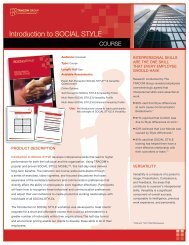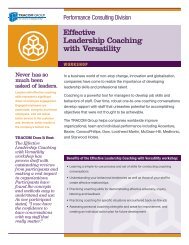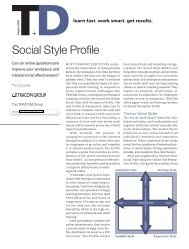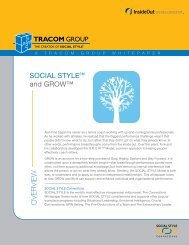Sales Concepts Guide Sneak Peek
Sales Concepts Guide Sneak Peek
Sales Concepts Guide Sneak Peek
You also want an ePaper? Increase the reach of your titles
YUMPU automatically turns print PDFs into web optimized ePapers that Google loves.
TRACOM <strong>Sneak</strong> <strong>Peek</strong><br />
Excerpts from<br />
Improving <strong>Sales</strong><br />
Effectiveness with Versatility<br />
The Application of SociAl STylE<br />
concepts <strong>Guide</strong>
Table of Contents<br />
Page<br />
Introduction . . . . . . . . . . . . . . . . . . . . . . . . . . . . . . . . . . . . . . . . . . . . . . . . . . . . . . . . . . . . . . . . 1<br />
Why is it Important to Learn about SOCIAL STYLE and Versatility? . . . . . . . . . . . . . . . . 1<br />
How the SOCIAL STYLE Model <br />
is Unique . . . . . . . . . . . . . . . . . . . . . . . . . . . . . . . . . . . . 2<br />
<strong>Sales</strong> Survey. . . . . . . . . . . . . . . . . . . . . . . . . . . . . . . . . . . . . . . . . . . . . . . . . . . . . . . . . . . . . . 3<br />
Overview of this <strong>Guide</strong> . . . . . . . . . . . . . . . . . . . . . . . . . . . . . . . . . . . . . . . . . . . . . . . . . . . . . 4<br />
SOCIAL STYLE Fundamentals . . . . . . . . . . . . . . . . . . . . . . . . . . . . . . . . . . . . . . . . . . . . . . . 5<br />
Sampling the Personality Pie. . . . . . . . . . . . . . . . . . . . . . . . . . . . . . . . . . . . . . . . . . . . . . . . . 5<br />
The “Say and Do” Standard. . . . . . . . . . . . . . . . . . . . . . . . . . . . . . . . . . . . . . . . . . . . . . . . . . 6<br />
Predicting Behaviors . . . . . . . . . . . . . . . . . . . . . . . . . . . . . . . . . . . . . . . . . . . . . . . . . . . . . . . 7<br />
Behaving with Style. . . . . . . . . . . . . . . . . . . . . . . . . . . . . . . . . . . . . . . . . . . . . . . . . . . . . . . . 8<br />
Assertiveness . . . . . . . . . . . . . . . . . . . . . . . . . . . . . . . . . . . . . . . . . . . . . . . . . . . . . . . . . . . 8<br />
Responsiveness. . . . . . . . . . . . . . . . . . . . . . . . . . . . . . . . . . . . . . . . . . . . . . . . . . . . . . . . . 10<br />
The SOCIAL STYLE Model <br />
. . . . . . . . . . . . . . . . . . . . . . . . . . . . . . . . . . . . . . . . . . . . . . . . 12<br />
Dimensions of Behavior . . . . . . . . . . . . . . . . . . . . . . . . . . . . . . . . . . . . . . . . . . . . . . . . . . . 12<br />
Showing Your Own Style . . . . . . . . . . . . . . . . . . . . . . . . . . . . . . . . . . . . . . . . . . . . . . . . . . 12<br />
Creatures of Habit . . . . . . . . . . . . . . . . . . . . . . . . . . . . . . . . . . . . . . . . . . . . . . . . . . . . . . . . 17<br />
Unlocking the Keys to SOCIAL STYLE . . . . . . . . . . . . . . . . . . . . . . . . . . . . . . . . . . . . . . 18<br />
Tension Management . . . . . . . . . . . . . . . . . . . . . . . . . . . . . . . . . . . . . . . . . . . . . . . . . . . . . . . 19<br />
Turning the Tension Channel. . . . . . . . . . . . . . . . . . . . . . . . . . . . . . . . . . . . . . . . . . . . . . . . 19<br />
Tension: Motivator or Instigator? . . . . . . . . . . . . . . . . . . . . . . . . . . . . . . . . . . . . . . . . . . . . 20<br />
Getting Run Over by “Backup Behavior”. . . . . . . . . . . . . . . . . . . . . . . . . . . . . . . . . . . . . . 21<br />
Avoiding the Need for Toxic Clean-Ups . . . . . . . . . . . . . . . . . . . . . . . . . . . . . . . . . . . . . . . 22<br />
Versatility . . . . . . . . . . . . . . . . . . . . . . . . . . . . . . . . . . . . . . . . . . . . . . . . . . . . . . . . . . . . . . . . . 24<br />
Selling in the Third Dimension . . . . . . . . . . . . . . . . . . . . . . . . . . . . . . . . . . . . . . . . . . . . . . 24<br />
Support and Respect—A Necessary Ingredient for <strong>Sales</strong> Effectiveness. . . . . . . . . . . . . . . 25<br />
Gaining Support and Respect—One Step at a Time . . . . . . . . . . . . . . . . . . . . . . . . . . . . . . 27<br />
Next Step . . . . . . . . . . . . . . . . . . . . . . . . . . . . . . . . . . . . . . . . . . . . . . . . . . . . . . . . . . . . . . . . . 28<br />
FAQs . . . . . . . . . . . . . . . . . . . . . . . . . . . . . . . . . . . . . . . . . . . . . . . . . . . . . . . . . . . . . . . . . . . . 29<br />
© The TRACOM Corporation, All Rights Reserved.<br />
CONCEPTS<br />
GUIDE
Introduction<br />
WHY IS IT IMPORTANT TO LEARN ABOUT<br />
SOCIAL STYLE SM<br />
AND VERSATILITY?<br />
This guide is designed to teach you about<br />
SOCIAL STYLE and Versatility concepts<br />
and how they can help you develop skills to<br />
become a more effective salesperson. By applying<br />
the SOCIAL STYLE and Versatility concepts in<br />
this guide, you can develop better relationships with<br />
your customers and get more done, faster, with less<br />
effort. Plus, your customers will most likely<br />
increase their levels of support and respect for you.<br />
Simply stated, here’s how it works. You have<br />
preferred ways to act and interact with your<br />
customers. For example, when you begin the sales<br />
process you may prefer to move fast, gather just the<br />
necessary facts, contact people, and get things<br />
going right away; or, you may prefer to take things<br />
slower as you sort out the details, consider<br />
alternatives, and contemplate the consequences of<br />
taking one course of action versus another. These<br />
behavioral preferences and patterns of behavior are<br />
a part of your SOCIAL STYLE.<br />
Your customers also have their own behavioral<br />
preferences or SOCIAL STYLE. As you know from<br />
past interactions their SOCIAL STYLE can be quite<br />
different than your own. How effective you are with<br />
your customers depends on how you take their<br />
preferences into account, and how well you control<br />
your own. Your impact and effectiveness on your<br />
customers is a result of another key concept,<br />
Versatility.<br />
Consider the variety of people you call on. Perhaps,<br />
one speaks loudly and prefers to dominate the sales<br />
conversation; another is highly focused on making<br />
the purchase and getting the deal done; another<br />
goes out of his way to be friendly and often ends up<br />
talking about matters unrelated to the sale. These<br />
© The TRACOM Corporation, All Rights Reserved.<br />
and many other characteristic ways of acting and<br />
interacting with people are expressions of a<br />
person’s SOCIAL STYLE.<br />
Your success in selling to a diverse range of<br />
customers depends on: your technical skills as a<br />
salesperson; specialized knowledge about your<br />
products or services; and, your ability to make your<br />
relationships mutually productive. The essence of<br />
Improving <strong>Sales</strong> Effectiveness with Versatility, is<br />
how you increase the interpersonal effectiveness<br />
and productivity between you and your customers<br />
and how you earn their support and respect.<br />
Improving <strong>Sales</strong> Effectiveness with Versatility can<br />
also help you effectively plan and prepare for<br />
customer interactions. Approach customers and<br />
analyze their needs, present results, handle<br />
objections and gain their commitment. 1<br />
You can<br />
learn to resolve, or even head off, unnecessary<br />
conflict caused by “interpersonal friction” that may<br />
arise during the give-and-take of the sales process.<br />
1<br />
CONCEPTS<br />
GUIDE<br />
“Commitment” refers to any significant decision you ask a<br />
customer to make such as: making a decision to purchase the<br />
product or service you sell or entering into an agreement with<br />
you or your organization.<br />
1
Introduction Identifying the SOCIAL STYLE of your Customers<br />
sales survey<br />
A TRACOM study surveyed recent SOCIAL<br />
STYLE training participants, who worked in sales,<br />
to determine how effective SOCIAL STYLE had<br />
been in their daily sales activities.<br />
The survey questions focused on tasks specific<br />
to salespeople including developing relationships<br />
with customers, gaining customer trust, and<br />
closing sales.<br />
Because the sales profession relies heavily on<br />
solid relationships, TRACOM wanted to research<br />
how SOCIAL STYLE training could contribute to<br />
better relationships and, ultimately, more sales.<br />
© The TRACOM Corporation, All Rights Reserved.<br />
Summary of Findings<br />
CONCEPTS<br />
GUIDE<br />
TRACOM’s study found that SOCIAL STYLE<br />
training could dramatically impact a salesperson’s<br />
ability to create more positive relationships with<br />
current and potential customers.<br />
A majority of the surveyed salespeople felt that<br />
SOCIAL STYLE training helped them establish<br />
better relationships and gain trust with customers<br />
and prospects.<br />
Over half of the survey participants felt that as a<br />
direct result of SOCIAL STYLE training, they<br />
were able to close sales they otherwise might not<br />
have. The chart below illustrates the key findings.<br />
EFFECTIVENESS OF SOCIAL STYLE FOR SALESPEOPLE<br />
key findings* percentage<br />
More conscious about how their behavior impacts their customers 94%<br />
Applied SOCIAL STYLE to their sales job 93%<br />
Developed more positive relationships with customers 92%<br />
Believe that their customers now have a greater sense of confidence and trust in them 87%<br />
Increased ability to influence or persuade customers or prospects 87%<br />
Improved ability to gain ongoing sales 78%<br />
Build relationships with prospects more quickly 76%<br />
Customers now more willing to disclose relevant information 75%<br />
Convert prospects to customers more quickly 69%<br />
Closed sales they otherwise might not have 58%<br />
*TRACOM Corporation (2006), Centennial, CO. Visit www.tracomcorp.com for research and whitepapers.<br />
The percentage reflects salespeople who either strongly agreed or agreed to the statements.<br />
3
SOCIAL STYLE Fundamentals<br />
SAMPLING THE PERSONALITY PIE<br />
As an individual, you have a unique<br />
personality made up of a jumbled<br />
collection of emotional patterns, mental<br />
processes and thought patterns, values, and<br />
behavior patterns which are all influenced by<br />
genetics and personal experience. Accurately<br />
describing and explaining your personality would<br />
not just be difficult, it would be impossible.<br />
It’s little wonder that great minds like Albert<br />
Einstein stuck to simpler tasks like figuring out the<br />
nature of matter and energy in the universe! The<br />
SOCIAL STYLE Model, following Einstein’s<br />
wise example, doesn't try to figure out your<br />
personality either.<br />
Style is like the crust of the<br />
personality pie. It’s the part<br />
that can be seen — the<br />
observable behavior.<br />
© The TRACOM Corporation, All Rights Reserved.<br />
PERSONALITY PIE<br />
CONCEPTS<br />
GUIDE<br />
SOCIAL STYLE deals with just your behaviors,<br />
that part of your personality that can be<br />
objectively observed. The word personality comes<br />
from the Latin word persona, which means<br />
“mask.” This term is appropriate, since<br />
personality comprises both visible and hidden<br />
qualities. In a simple analogy, personality can be<br />
compared to a pie. The inside of the pie, like much<br />
of your personality, is out of direct view and<br />
contains a mix of ingredients that give the pie a<br />
unique texture and flavor. Behavior is like the<br />
crust, the outer part of the pie that everyone can<br />
see and describe in more or less the same way.<br />
Like the crust of the Personality Pie, SOCIAL<br />
STYLE behaviors are particular patterns of action<br />
that people can observe and agree upon for<br />
describing a person’s usual behavior.<br />
The personality includes;<br />
inner qualities, attitudes,<br />
aptitudes, dreams, values,<br />
and abilities.<br />
5
THE “SAY AND DO” STANDARD<br />
Observable behaviors are what you say (verbal<br />
behaviors) and do (non-verbal behaviors) with no<br />
judgments by the observer as to why. Observable<br />
behaviors are interactions between two people<br />
whose behaviors can be observed and verified by<br />
others. The interaction could be between you and<br />
your customer or between you and a prospective<br />
buyer. Notice that the “Say and Do” Behaviors<br />
listed below are not “either-or” propositions.<br />
Rather, they represent continuums, for example,<br />
from quieter to louder, or from less to more direct<br />
eye contact.<br />
6<br />
SOCIAL STYLE Fundamentals<br />
OBSERVABLE “SAY AND DO” BEHAVIORS<br />
Quieter<br />
Slower paced<br />
More facially controlled<br />
Less inflected voice<br />
Less direct eye contact<br />
More casual posture<br />
Leans back<br />
-<br />
-<br />
-<br />
-<br />
-<br />
-<br />
-<br />
Louder<br />
Faster paced<br />
More facially animated<br />
More inflected voice<br />
More direct eye contact<br />
More rigid posture<br />
Leans forward<br />
© The TRACOM Corporation, All Rights Reserved.
Responsiveness<br />
Responsiveness is a dimension of observable<br />
behavior that measures the degree to which others<br />
see you as tending to control or emote when<br />
interacting, that is, the degree to which you<br />
display, or don’t display, your feelings and<br />
emotions. Note that, as used here, “control” does<br />
not mean that the person controls the situation and<br />
“emote” does not mean that the person's emotions<br />
are dramatic or “out of control.”<br />
10<br />
Emotion<br />
In<br />
Voice<br />
SOCIAL STYLE Fundamentals<br />
More Controlling<br />
More Emoting<br />
As with the Assertiveness Scale, you can use the<br />
various verbal and non-verbal clues shown in the<br />
Behaviors on the Responsiveness Scale to<br />
identify a pattern in a person's behaviors, based on<br />
what you observe a person actually saying or<br />
doing over time.<br />
BEHAVIORS ON THE RESPONSIVENESS SCALE<br />
Verbal Behaviors Non-Verbal Behaviors<br />
Monotone Task Facts/Data<br />
Subjects<br />
of<br />
Speech<br />
Form<br />
of<br />
Descriptives<br />
Inflection People Opinions/Stories<br />
EMOTES CONTROLS<br />
Less<br />
Use of<br />
Hands<br />
More<br />
More Controlling<br />
Rigid<br />
Body<br />
Posture<br />
Casual<br />
More Emoting<br />
Controlled<br />
Facial<br />
Expression<br />
Animated<br />
© The TRACOM Corporation, All Rights Reserved.
The SOCIAL STYLE Model TM<br />
The Driving Style<br />
“Let's get it done, now.”<br />
People with a Driving Style are seen by others as<br />
active, forceful, and determined. People with a<br />
Driving Style are direct; they initiate social<br />
interaction and they focus their efforts and the<br />
efforts of others on the goals and objectives that<br />
they wish to get accomplished now. People with a<br />
Driving Style are typically described by others as<br />
cool, less personable, guarded and, at times, aloof,<br />
as they typically do not openly show their feelings<br />
or reveal the depth of their emotions.<br />
People seen as having a Driving Style appear to:<br />
� Know what they want<br />
� Have little difficulty conveying their<br />
conclusions about anything that concerns them<br />
� Focus on the immediate time frame with<br />
relatively little concern for the past or future<br />
� Be swift, efficient and to the point<br />
� Be impatient with delays<br />
� Show less concern for the feelings of others or<br />
for personal relationships<br />
� Be harsh, severe or critical due to their limited<br />
attention to relationships<br />
� Be efficient and decisive<br />
� Seek control through the use of power<br />
� Use time in a disciplined manner<br />
© The TRACOM Corporation, All Rights Reserved.<br />
DRIVING STYLE HIGHLIGHTS<br />
� Faster paced<br />
� Make efforts to set the pace<br />
� Seem less concerned for the value in<br />
relationships<br />
� Work in the present time frame<br />
� Tend to direct the actions of others whether or<br />
not they are the leader<br />
� Tend to avoid inaction<br />
CONCEPTS<br />
GUIDE<br />
13
SELLING IN THE THIRD DIMENSION<br />
With a basic understanding of the two<br />
dimensions of behavior, Assertiveness<br />
and Responsiveness that form the<br />
SOCIAL STYLE positions, you should now have<br />
a much better understanding of the behavioral<br />
tendencies of your customers in any given<br />
situation and you should be able to take actions to<br />
work with them more effectively. However, there<br />
is one more dimension to the SOCIAL STYLE<br />
Model. This dimension, Versatility, is critical to<br />
creating productive and successful interpersonal<br />
interactions.<br />
24<br />
Versatility<br />
The Versatility Dimension is not behavioral but<br />
instead reflects the impact or effect your behavior<br />
has on the amount of support and degree of respect<br />
(sometimes called “social endorsement”) you earn<br />
from others, such as co-workers and customers.<br />
Unlike Assertiveness and Responsiveness, which<br />
are relatively stable and consistent over time, the<br />
support and respect that you earn from your<br />
customers can increase or decrease depending on<br />
your willingness to work toward mutually<br />
productive interactions. Also, with Versatility, the<br />
more support and respect you earn, the more<br />
effective you are likely to be, unlike the behavioral<br />
dimensions where there is no best place to be, no<br />
good or bad style.<br />
VERSATILITY DIMENSION<br />
Behaviors Seen as<br />
Focusing on<br />
My Tension<br />
Versatility<br />
Low Me dium High<br />
To increase your sales effectiveness, you must have<br />
the support and respect of your customers. Your<br />
particular style of behavior matters less than how<br />
you actually use your behavior to gain that support<br />
and respect. Your ability to earn your customers’<br />
support and respect is reflected in their perception<br />
of your Versatility, that is, your ability to relate to<br />
them in a way that makes them feel comfortable,<br />
helps them to achieve their purchase objective, to<br />
satisfied with you and the sales process. In fact,<br />
simply being seen as genuinely trying to help them<br />
succeed in the purchase process can increase your<br />
Versatility.<br />
A critical aspect of Versatility in the sales process is<br />
whether your customers see you as tending to focus<br />
on reducing your own tension or on reducing their<br />
tension. <strong>Sales</strong> people who are not overly focused on<br />
meeting their own style Need and are versatile<br />
enough to adapt their behaviors to helping<br />
customers to meet their style Needs are seen as<br />
having higher Versatility.<br />
The greater your willingness to accommodate<br />
others and adapt to situations, the greater likelihood<br />
of a higher Versatility score. TRACOM’s research<br />
shows that higher Versatility scores lead to<br />
interpersonal effectiveness and success.<br />
Behaviors Seen as<br />
Focusing on<br />
Others' Tension<br />
© The TRACOM Corporation, All Rights Reserved.











